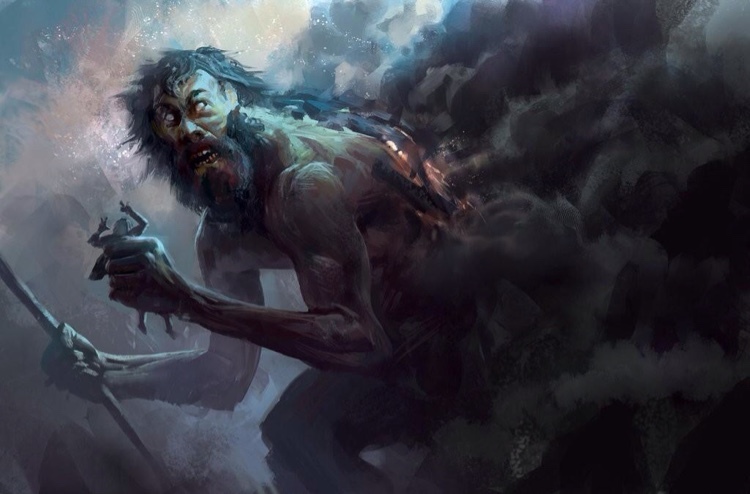Chinnamasta
Chinnamasta is depicted as a girl of sixteen years adorned with garland of skulls and necklaces of bones. She wears on her naked body a serpent as the sacred thread (yajnopavita) and she has full breasts covered by lotus flowers and strings of beads. but the most gruesome aspect of her is that she has cutoff her own head with a sword and holds in her hands the severed head as also the sword. The blood gushing out of her decapitated head sprouts in three jets. The central Jet streams into the mouth of her own head , usually held in her left hand , while the other two jets fall into the mouths of her two companions Dakini and Varnini - standing on her either side.
Chinnamasta, in a single frame, makes a stunning presentation of varying and conflicting aspects of life and death; of self destruction while nourishing others;of death by violence and enjoyable sex; of gory violence spilling blood and smiling blissful face; death and destruction placed next to creation; of the joy of transcending the body and not the pain of losing it; and of giving up the ego to attain wisdom. It combines in itself the elements of heroism(vira), terror (bhayanaka) and eroticism (srungara) and portrays, in its own manner, a composite picture of life where all life events become intrinsic parts of unified scheme. It enfolds the entire multiplicity of life. Chinnamasta in her energetic form shows the power of transformation in action.
Taken all together, the symbolism in Chinnamasta’s depiction represents the transcendence of the body. Standing on the couple having sex, she has mastered the physical body, and then by cutting off her head she frees the mind. Her happy face shows the joy that she feels in bringing together life, sex, and death—three forms of transformation, three parts of the cycle.
STORY
Stories of her origin vary, but one relates that Parvati was bathing with two attendants, Jaya and Vijaya, when the attendants asked the Goddess to satisfy their hunger. After putting them off several times, Parvati looked all around and then cut off her own head. Three streams of blood came from her neck—one went to the mouth of Jaya, one to the mouth of Vijaya, and the last to the mouth of Parvati herself. At this point, Parvati is transformed into the Goddess Chinnamasta, whose name literally means “severed head.” When they were satisfied, she put her head back on, became Parvati again, and went home. In other versions, the attendants are named Dakini and Varnini, and Chinnamasta is standing on a couple in the middle of having sex. The couple is Rati, Goddess of sexual desire, and her husband Kama, God of love.
Goddess Chinnamasta is the insight of mystery and signifies spiritual truth regarding the fulfillment of worldly desires. In certain pictures she is depicted as standing on the body of a female who has been copulating with a male lying beneath her. It is from her navel that the divine Yoni Chakra is originated. Her body is covered by the four directions in place of clothes. She is believed to be eternal even though her head is removed from the body. Her two main qualities are highlighted by the features of her companions. The goddess is the image of sexual energy and her severed head is the symbol of inherent achievements. Her consciousness in creativity is represented by her garlands of skulls.
She is called a pure Yogini. This is why she is called by names like Vajra Yogini, supreme Dakini or Para Dakini. Those who wish to get empowered with the occult worship her ardently. Her left foot is positioned in a manner that shows she is ready to move or is always ‘on the go’. In her hand she also carries a knife along with the severed head. A serpent is around her neck and she has three eyes. Despite all her fearsome features she is considered satvik and very feminine. Once she blesses the devotee he is protected for life.
The Devi is harsh on her self as she sacrifices her head. As she has immense self-control she is considered a yogi of the finest order. Since she is able to sacrifice her own head it means she is capable of spiritual advancement. Chinnamasta’s image represents maybe the most energic form of manifestation of the goddess Shakti eloquently indicating the power of transformation in full action.
As a result of this fact, the cut head does not appear as lifeless, but it is even more alive than previously. The consciousness is not limited at the dimensions and functions of the body, but it exists separately from it.
Only when it is freed from the “prison” of the body the consciousness can express itself plenary, acquiring the profound divine freedom and knowledge.
Even if the idea of transcending the corporal consciousness can be frightening for certain people, the idea of remaining confined to the bodily consciousness and being subject to the influence of the body and death appears as even more frightful.
From this point of view, we can say that Chinnamasta acts mainly in what we call the intermediary world, in that world that connects the transcendent aspect of the manifestation with the material one.
Thus she represents the lightning that unifies the sky and the earth, which are analogically associated with the mind and the body of the human being.
Her fundamental goal is to free the people from the limitations inherent to their condition of incarnate spirits.











Comments
Post a Comment